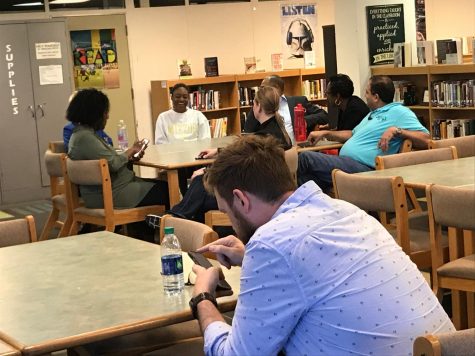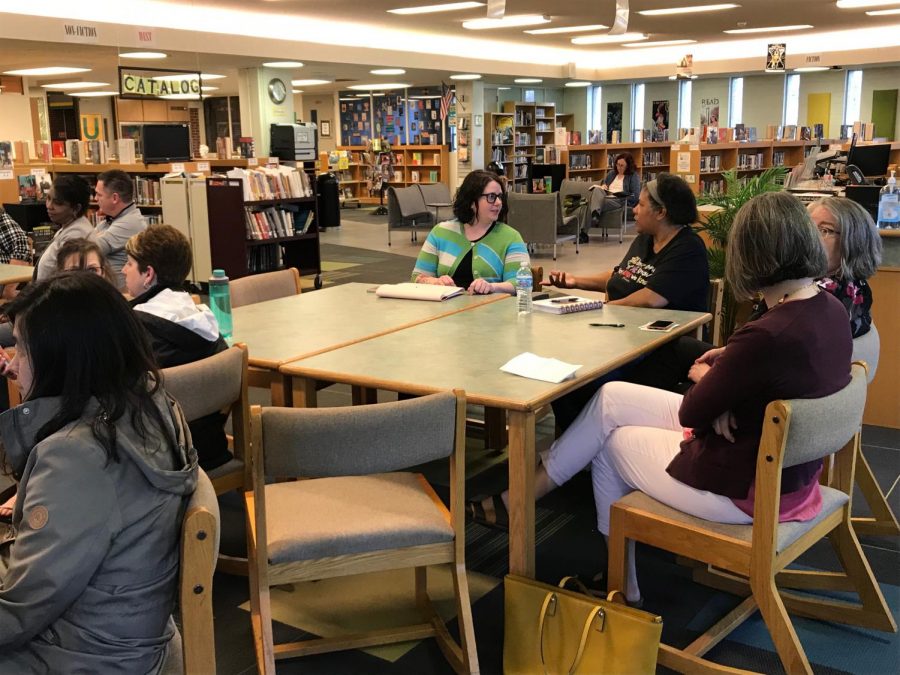Bias-based incident: What happened and where do we go from here?
Parents participated in a Town Hall meeting with Superintendent Dana Kinley and U-High administrators on Tuesday, April 9, to share perspectives on the swastika incident that occurred prior to spring break.
April 11, 2019
After school on March 6th, the week before spring break, a student in the boy’s locker room wrote in spray deodorant “I hate minorities” and drew a swastika on a group of seven lockers. The locker room was accessible for entry due to the multiple extracurricular activities occurring at that time.
Administration had no knowledge of the message until the morning after, when some students entered the locker room before their 7 o’clock PE class and then informed PE teacher Steve Paxson.
“I went into the locker room, and the students showed me what they had seen when they had came in to dress that morning,” Paxson said. “I got the students out of the room immediately after they showed me, then I talked to Mr. Evans and took pictures of everything and sent them to him.”
Assistant principal Steve Evans relayed information of the incident to principal Andrea Marker, who was shocked.
“I’ve been here for 15 years and I’ve never had anything like this before,” Markert said. “I was really angry that someone would make other students feel unwelcome and unsafe because it is entirely against our philosophy.”
Clarifying misconceptions
U-High’s position as a lab school makes the investigation process quite different than those other high schools may have to go through.
“[The process] does differ a lot because other schools would deal with the police, but they wouldn’t have to go through university offices, so they may not have to go through this time period of waiting,” Markert said.
Markert notified police of the incident the same day. Since U-High is a lab school under ISU, the investigation was carried out by the ISU police. ISU Chief of Police Aaron Woodruff was in charge of the case.
“By the time that we got called, everything was taken care of and the material was already wiped off,” Woodruff said. “The school responded very quickly.”
The role of the police was to determine if the incident was criminal; it was not.
“So in order for something to be hate crime, there has to be some other offense first,” Woodruff said. “If it was done with a key and it was etched in the lockers, that would be a criminal defacement, so you would have a criminal offense. But because it was done using spray deodorant, which is easily wiped off, we didn’t actually have any crime.”
Since the incident didn’t rise to the level of a crime, there will be no further police action. This, however, is independent of potential action on the part of school administration.
“Just because it’s not criminal, doesn’t mean that there aren’t repercussions for it,” Woodruff said.
An additional investigation was conducted by the university.
“Because it is a bias-based incident, it was referred to the Office of Title IX, here at the university,” Woodruff said. “Their responsibility is to look at any incidents of harassment, whether it’s sexual or based on gender, race, or ethnicity, and they investigate those incidents.”
The Office of Title IX, also known as the Office of Equal Opportunity and Access, considers information documented by the police, speaks with all the parties involved, and makes a determination of whether any university policies were violated. Their findings are passed to administration, which determines disciplinary action.
At a recent town hall meeting with concerned parents, Markert confirmed the investigation is closed and discipline has been carried out. Due to privacy laws, administration is legally prohibited from identifying the student and stating what discipline this individual has received.
What administration confirmed, however, is that the incident was deemed a level III offense and all school procedures, as indicated in the student handbook, and university procedures have been followed.
School community in the meantime
It is during the period after the incident that many students have expressed their frustrations. One such frustration centered on disagreement over whether the student’s actions were a joke.
Senior Kate Humphrey was disappointed by this particular defense of the incident.
“Because if this is a joke, then how far can a joke actually go and be deemed okay?” Humphrey asked. “What kind of environment does that cultivate here at U-High?”
Senior Boston Cooper III also felt that this incident was unacceptable.
“The reason it’s important to me, as a student of color, I feel that I should be able to feel okay around my fellow students,” Cooper said. “I shouldn’t have to be like, ‘is this how a lot of people think? Was it just him or was it everybody else?’ I shouldn’t have to be on edge.”
School, after all, should be a safe space for its students, and the question remains whether events like these can be prevented in the future.
“We should be making sure that we have this community of acceptance and tolerance overall, and understanding that everyone is a human being,” Humphrey said.
Both Humphrey and Cooper expressed concern that there is a deeper issue of student culture at the heart of this incident.
“The fact that people didn’t call him out, tell him to stop, the fact that nobody said anything, is what actually bothers me, and what I think U-High needs to grow on,” Cooper said. “The culture of U-High needs to be at a point where we’re able to speak up to one another.”
With an eye towards this need, two groups of teachers are working on many facets of diversity and inclusion within the school. The diversity committee addresses school policies on issues of diversity and a professional development group addresses student climate. These groups coordinated the February Diversity Retreat for students and the microaggressions training for faculty which occurred on March 22.
The microaggressions training was conducted by ISU’s Student Counseling Services and was similar to one of the sessions students participated in at the Diversity Retreat. Math teacher John Neisler noted that the purpose of the training went beyond bringing awareness to microaggressions and their impact on people.
“[One purpose was] not necessarily how to avoid microaggressions, because it’s hard to avoid, at some point we’re going to mess up, but more about how to handle the mistake and how to deal with it on the back end of it,” Neisler said.
Additionally, the administration hosted a town hall meeting hosted on April 9 to facilitate address parent concerns about response to the incident and school safety.
 Parent Karin McDowell attended with an open mind.
Parent Karin McDowell attended with an open mind.
“I think they listened, and they acknowledged that they could have handled the situation better and will do better in the future, and that really was appreciated,” McDowell said.
One goal was to establish connection between the school and parents, and parent Sue Jung Han believes was accomplished.
“Having this ongoing communication channel between the school administration and the parents is really valuable,” Han said. “I think it’s a wonderful start.”
The meeting benefits were twofold: it gave input to administrators and it allowed parents to share with each other.
“Part of [its importance] is showing up for the conversation, hearing what other people have to say, whose experiences are not like mine, and trying to be a part of the solution instead of sitting back and saying they could have done better,” McDowell said.
An idea expressed repeatedly at this meeting was the desire to see progress, including some important cultural changes.
“(I want) an environment where their (student) differences are not only just put up with, but celebrated,” Han said. “I think that’s really important.”
Markert emphasized that these changes cannot be accomplished alone.
“We want students to come talk to us about how they feel about it, about what their worried about, about what their concerns are, if they feel unsafe at school, or if they feel safe at school,” Markert said. “Whatever it is, we want open dialogue.”
